 |
 |
Home
Tools
Drilling and Fixing
Putting Things Up
Repairs/Maintenance
Plumbing
Electrics
Woodwork
Decorating a Room
Tiling
Safety & Security
Saving Energy
House and Finance
Health&Safety
Disclaimer
Contact
Advertising
Useful Links
Site Map
| Unblocking sinks/toilets/drains | |||||||||||||||||||
Sinks/baths/showersSinks will often block up with grease food waste lime-scale etc. A blocked sink is fairly obvious. You will probably notice a slowing down of the water draining away. Try to do something about the problem asap as it will be much easier to unblock and you don't want to end up with it badly blocked and a sink full of water! There are various methods you can try both mechanical and chemical to fix a blocked sink. |
|||||||||||||||||||
| How to unblock a sink | |||||||||||||||||||
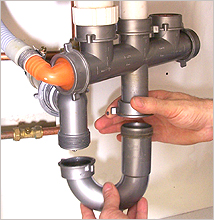 |
|||||||||||||||||||
Checkout the trap. This u-shaped water trap stops smells coming back up from the drains. This is the area to check if you lose any valables down the plughole.Heavy items often sit at the bottom rather than getting wahed away! |
|||||||||||||||||||
Plunging a blocked sink This can be effective and works by forcing air down the pipe. A traditional black rubber plunger is OK but modern ones or professional ones are much more effective as they force more air down the pipe. Some use water which is forced against the blockage. Tip This method will only work well if you block off any ways the air can escape like the overflow outlet, an adjacent sink plug hole, or a waste disposal. Hold a damp cloth over them, or, cover then with duck tape (thick heavy sticking tape) |
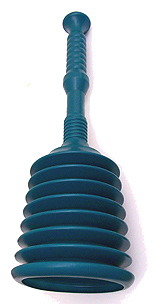 |
||||||||||||||||||
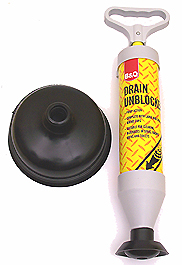 |
|||||||||||||||||||
| Master plunger. Gives great plunging action. Sinks baths, showers. £7 | Water plunger. Sucks up water then pumps it against the blockage. Toilet, sinks, showers. B&Q £7 |
||||||||||||||||||
Other mechanical methods Drain cleaning springs are essentially very long flexible springs which you guide down the waste pipe and turning as you go. |
 |
||||||||||||||||||
| Small drain spring. This one is for basins. | |||||||||||||||||||
Chemical Chemical un-blockers work by dissolving organic materials. These are very good at dissolving hair that you might find in the waste or trap of a shower or bath whose traps can be fiddly to get to. |
|||||||||||||||||||
 |
|||||||||||||||||||
Other methods for a blocked sink Some newer types of un blockers are currently available in a large aerosol which shoot a blast of air or liquid down the waste pipe. These can be highly successful, but only if you remember to make sure that every other exit is blocked off(see my tip above) similarly as you would when using a plunger. |
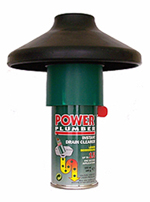 |
||||||||||||||||||
Power plunger aerosol unblocker |
|||||||||||||||||||
ToiletsI've never had much success with attempting to unblock WC's with chemical means so I tend to use mechanical methods. |
|||||||||||||||||||
DrainsFor outside drains use drain rods. This is not a very pleasant job at all. Drain rods are a series of flexible plastic rods which screw together. They come with various attachments which screw to the very end. For general drain unblocking I tend to use the claw. I like it as goes it easily and you can twist round when you feel an obstruction. Your drains will normally flow from the house towards the street. Occasionally they will go the other way out through the garden. You should find one or more large round or rectangular metal drain covers along the route. They are quite heavy so be careful when lifting them. Use a special drain lifting tool or if you can't get hold of one prise it up with a heavy duty screwdriver. If you can see water in side then it's blocked further along towards the main sewer so that is the place to try the rods. Use rubber gloves to feed the rods inside the drain. Eventually you should feel the blockage. Either use to the claw to twist and pull back toward you or push and twist the blockage till it frees up and the water flows. |
|||||||||||||||||||
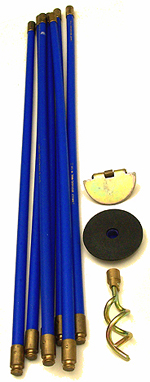 |
|||||||||||||||||||
| Set of drain rods with attachments. | |||||||||||||||||||
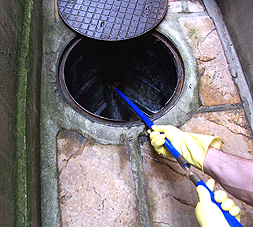 |
|||||||||||||||||||
If when you take up the cover the drain is clear then the blockage will probably be somewhere back towards the house. Try rodding backwards. Again I would tend to use the claw. If you push gently you can normally feel when you hit a blockage. The worst thing about rodding is that when you've sorted the blockage you then have to get the drain rods out and put them away. It can be a smelly horrible job (hence use rubber gloves).Have a hose pipe handy. I like where possible to hose each rod down as I dissemble it whilst I'm pulling it out then have a quick hose down into the drain before replacing the cover. |
|||||||||||||||||||
| Screw each rod in as you push further into the drain. Unscrew each one as you remove them. (I strongly advise you wear rubber gloves. Yuk!!) | |||||||||||||||||||